September 27 Auroras
Bowstring Lake, Itasca County
Solar wind conditions improved compared to the night before, with speeds staying in the 400-500 km/s range, density approaching 10/cc, and Bz dropping south to near -5 nT much of the time. In most times of the year, that would not ignite much auroral activity, but the proximity to the equinox made for a more likely development of auroras. Prior to this year, I had not really witnessed that phenomonon, but this has been the most active September since I've been paying close attention (2011).
I was chatting with my neighbor outside in the front yard, and other neighbors were walking past. The Facebook aurora groups indicated sightings already over the Upper Great Lakes area, and I tried to point out the glow on what little portion of the northern horizon we could see from our neighborhood, but it was really not easy to see against the background glow of haze-scattered city lights. Suddenly, a second band appeared much higher in the sky, and it was much clearer that this was an aurora. I ran inside to get my camera gear in the car to drive to a darker shooting location. Before I could do all this, the higher band of auroras disappeared.
I drove out to McKinney Lake on the north side of town and snapped a few pictures. The auroras had actually settled down a fair bit. There was only a dim green band on the horizon. I snapped a few pictures and contemplated what I would do next.
| Auroral oval over McKinney Lake just before 10:00 PM. |
Since Bz was only -5 nT, which would keep the auroral oval close to the horizon, yet there had been some relatively photogenic displays this week, I decided to go to a new location with a wide-open view of the northern horizon would be good. I had not shot auroras at Bowstring Lake before, and now was probably a good time to do that. It was a Friday night, and I could sleep in Saturday morning, so just after 10:00 PM, I started the drive northwest.
The auroras had maybe dimmed a little further by the time I arrived at the boat landing on the south end of Bowstring Lake. I would normally not be very encouraged by this, but Bz, after spending some time near zero, had dropped back to the -5 nT range, and it showed some indication of staying there for a while. I felt the activity would pick up at some point in the next couple hours.
| Dim auroral oval around 10:50 PM CDT on Bowstring Lake. |
Indeed, the oval started to rise higher into the sky, which meant that it was coming more southward. Such a progression is pretty typical since the oval typically reaches its most southern extent around local midnight as that local point rotates toward Earth's magnetotail, where most aurora-exciting electrons are accelerated toward the polar regions. At some point, usually between 10:00 PM and midnight (standard time), the oval suddenly brightens and breaks up into the sharply structured, waving and dancing display that most people envision when they think of the northern lights. This evening showed that same evolution with the substorm starting just after midnight daylight time.
Just as it was about to start, some duck hunters drove up to the boat landing. I was worried that I would have to miss the best part of the show, but there turned out to be plenty of room on the ramp for them to launch the boat and mostly stay out of the shot. They took in the auroras for a bit, then got their boat and dogs ready and headed out to claim their spot for the duck opener, which was just a few hours away.
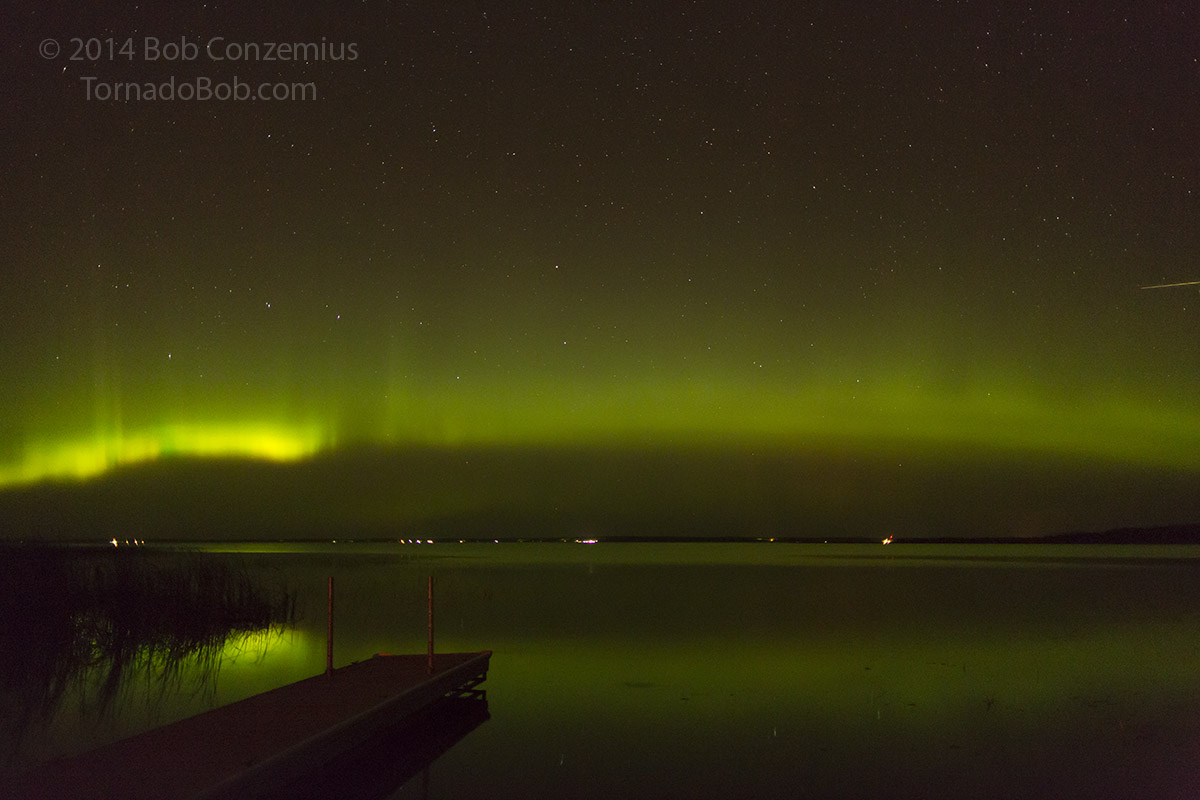 |
|---|
| A substorm starts to break out. |
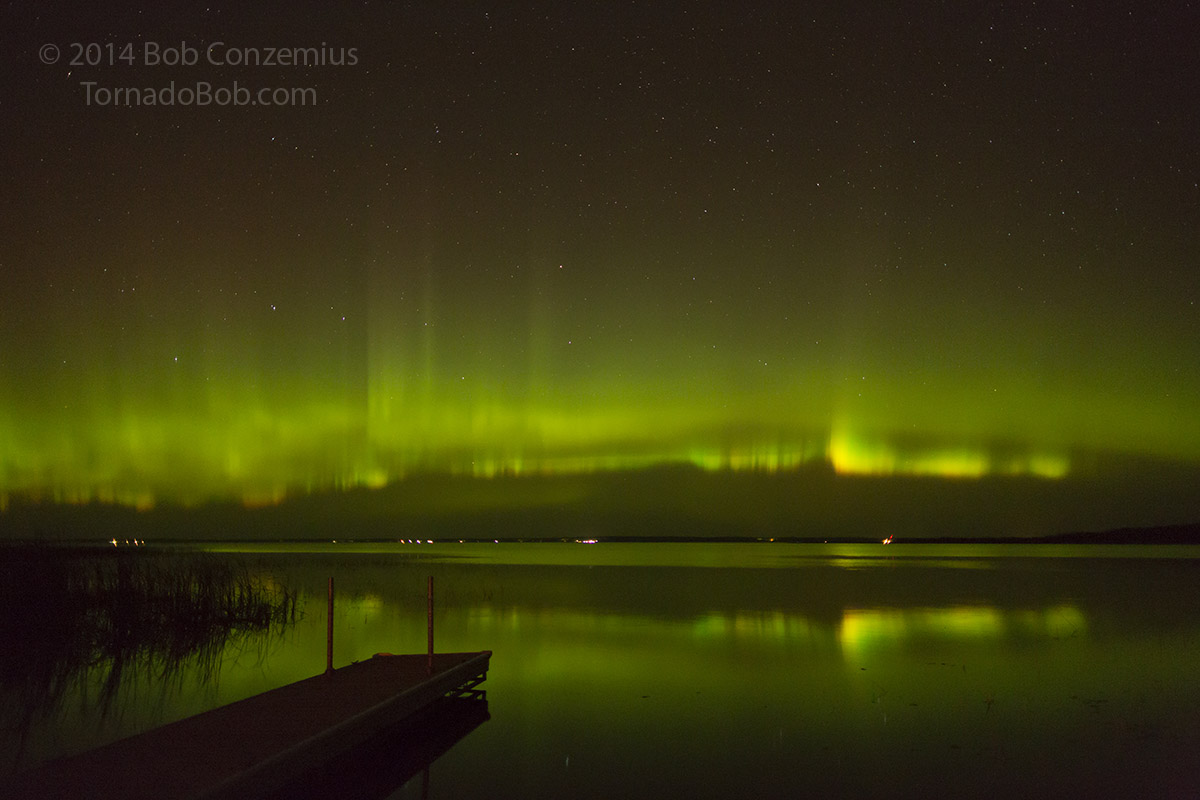 |
|---|
| I dropped the shutter speed down to 0.8 second and cranked the ISO up to 6400 to capture the finer structure of the substorm at 12:19 AM CDT. |
| About a minute later, this was probably the peak of the structure. |
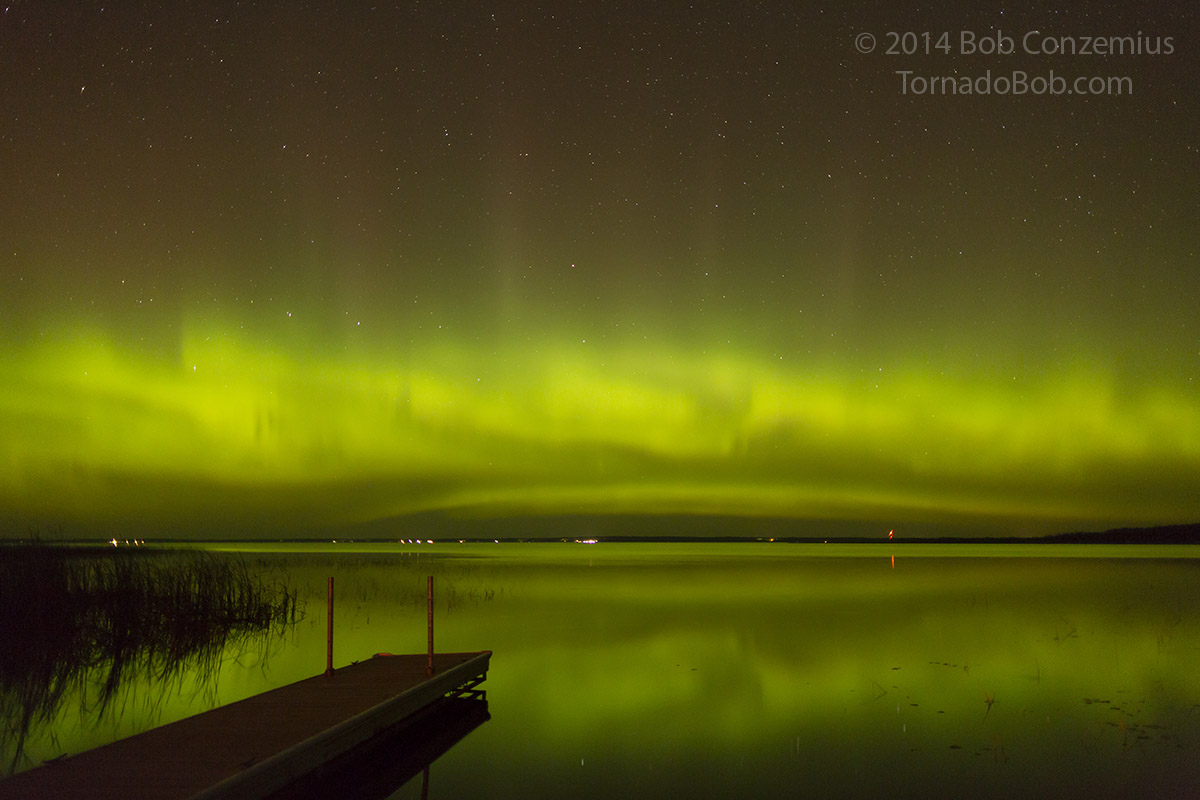 |
|---|
| Back to ISO 3200 and 2 seconds exposure at f1.4. |
| Back to ISO 1600 and 4 seconds exposure at f1.4. The duck hunters are shoving off. |
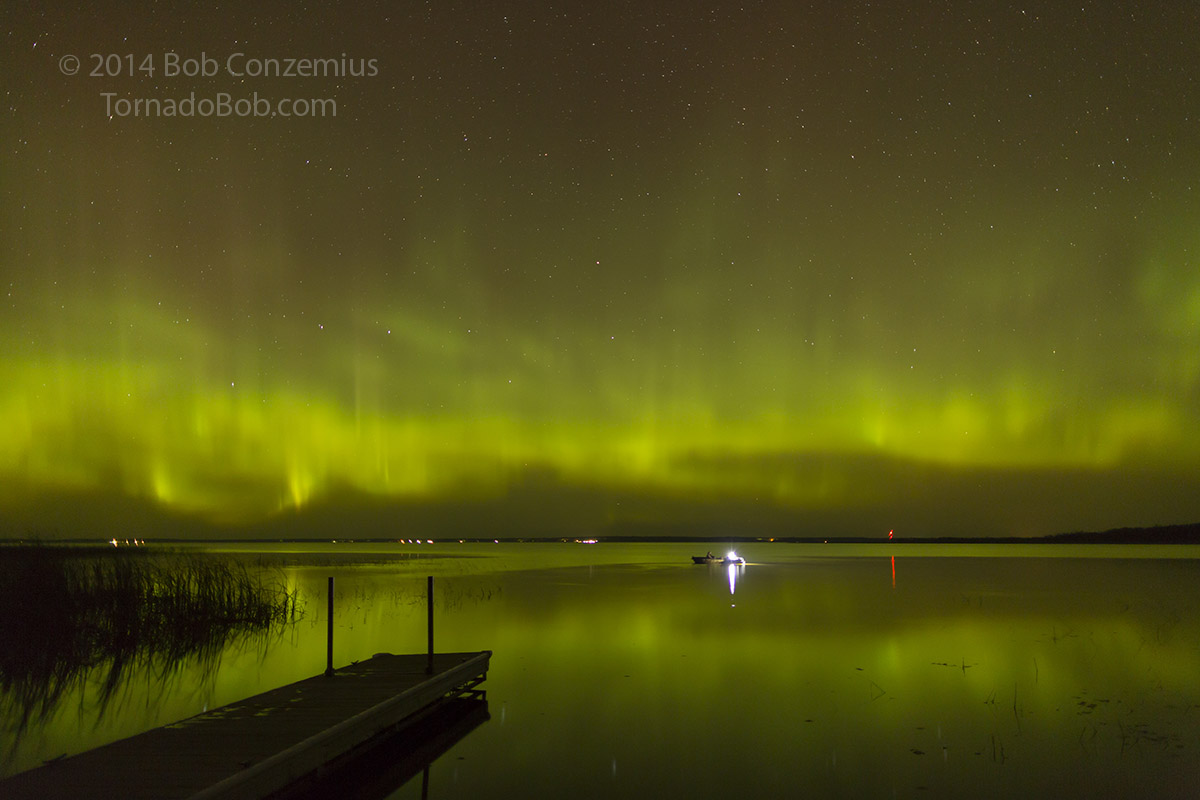 |
|---|
| Out into the lake. |
When they left, the substorm started to quiet. The brightness of the auroral elements diminished, and the display gradually shrank back to the oval I saw when I arrived. I continued to shoot, gradually increasing the exposure time and dropping the ISO as less structure was present, meaning I did not have to take shots as quickly to capture the evolution.
| The lake is clear again. |
| The substorm is fading at 1:01 AM. |
| Back to the oval at 1:30 AM. |
About when the oval had diminished to its original appearance, I heard, in the distance (most likely several miles away), a truck approaching, which meant that another group of hunters was probably on their way. The first group had told me that by 2:00 AM, enough groups start showing up that their favorite spot is usually occupied. Well, it was now approaching that time, so I decided I could either find another location closer to home or simply just head home.
I packed up to leave, but as soon as I put the car in gear, another substorm started. I quickly grabbed my tripod and camera and set them up, but like I so often do, I had forgotten to change the shutter speed from what it had previously been set at. In this case, it was the 30 seconds I had used as the auroras dimmed. Also, just as this exposure was finishing, the truck that I had heard a few minutes earlier had reached the parking lot and was now flooding the scene with light. That was enough. I tossed the camera and tripod back in the car and drove off.
I drove in the direction of home until I got to the first spot where I could once again see the northern horizon. This happened to be at the intersection of County Road 37 and Minnesota State Highway 6. I set the camera on top of the car and took a rooftop shot. It was not the best part of the substorm, but it was also not the last. When I got home, things had dimmed again, and I could not really make out the auroras from the city lights. I climbed on the roof to see if I could see better from there, but that did not improve the contrast. After that, I went to bed.
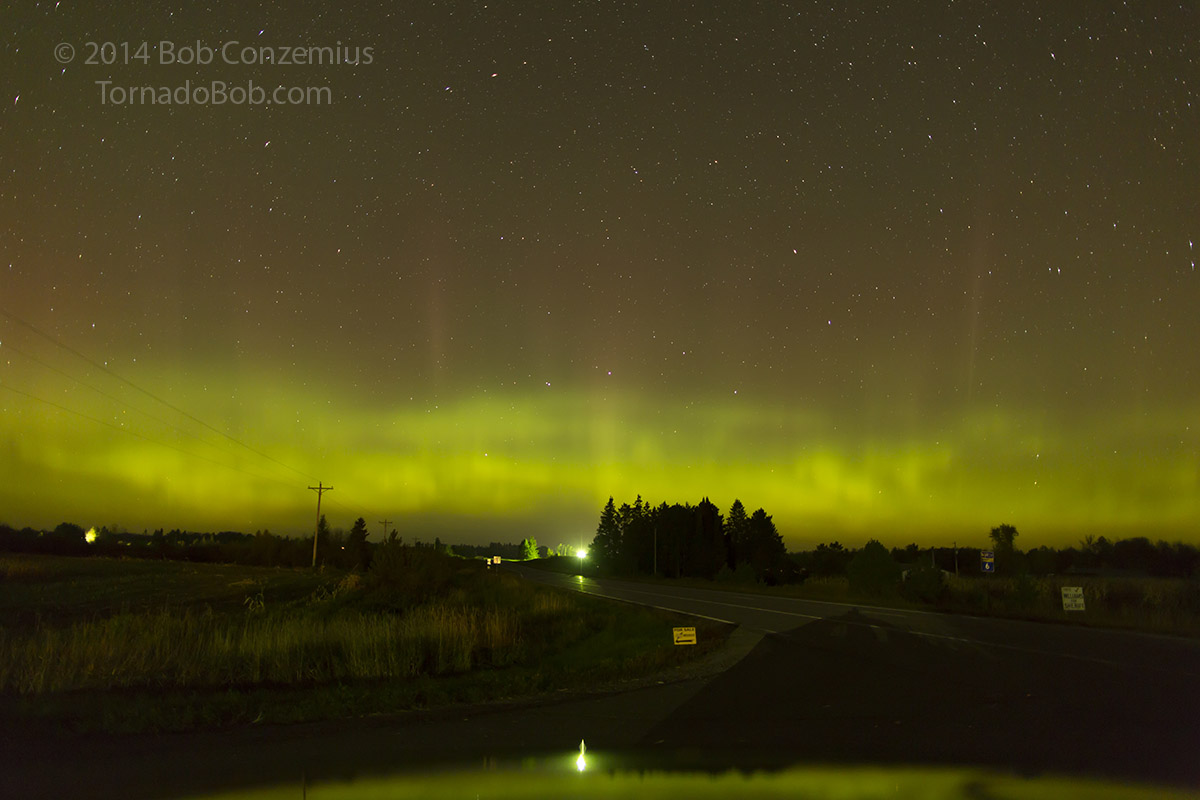 |
|---|
| A second, brief substorm at 1:52. |
Some More Highly Edited Images
While the first camera was running the time lapse, I walked around with the other camera composing various scenes with other lenses. I decided to process these shots a lot more. One thing, in particular, I like to evaluate is the white balance of the pictures. You might have noticed the sky is not really dark blue or black on the images above. Part of that is due to airglow, which renders the sky a little bit green as ozone and other molecules in the upper atmosphere are recombining and emitting small amounts of green light in the process.
I tend to leave my color temperature around 5200 K, which is where the camera generally sets it with the white balance set to daylight. This seems to be a decent reference as it renders the colors relative to what the most universal definition of white light is-- that is sunlight. Actually, if it weren't for the scattering in the atmosphere, the color temperature would be closer to 6000 K, but that's the sun viewed from above our atmosphere, which scatters out some of the higher frequency light, causing the color temperature to be cooler. What we see as daylight is in the 5200 K to 5500 K range. A good explanation of color temperature can be found here.
Anyway, I also did a fair bit of contrast enhancement and other things to sharpen the lights a bit. Here are the images.
 |
|---|
| The auroral oval about 10 minutes before the start of the substorm. Canon 16-35mm lens at 16mm, ISO 1600, f2.8, 30 seconds. |
 |
|---|
| Middle of the substorm at 12:35 AM. 16mm, f2.8, ISO 1600, 13 seconds. |
 |
|---|
| A second, brief substorm at 1:52. Samyang 24mm f1.4 at 8 seconds, ISO 800. |
Video
The video below shows a pretty typical auroral evolution in the late evening to just past midnight as the aurora starts as a dim oval, brightens, comes a little farther south, and ignites into a substorm, which then fills the sky. The auroras then settle down and retract back to the original oval.